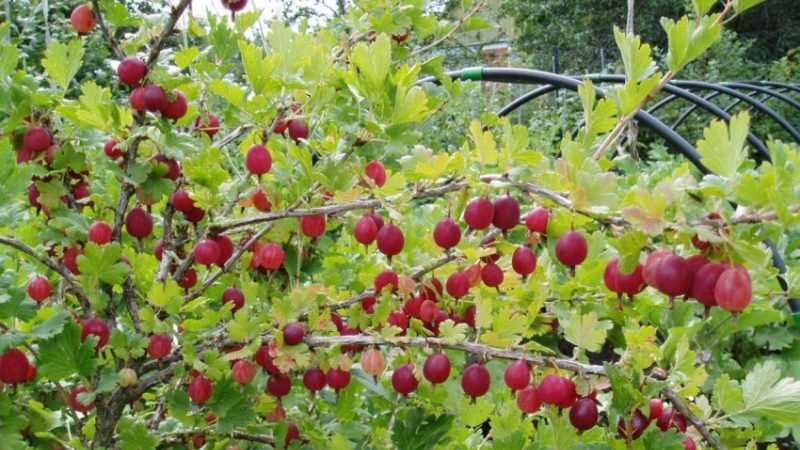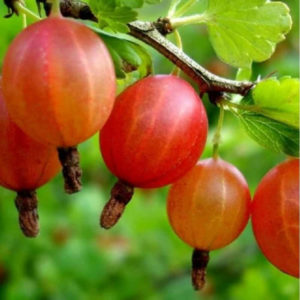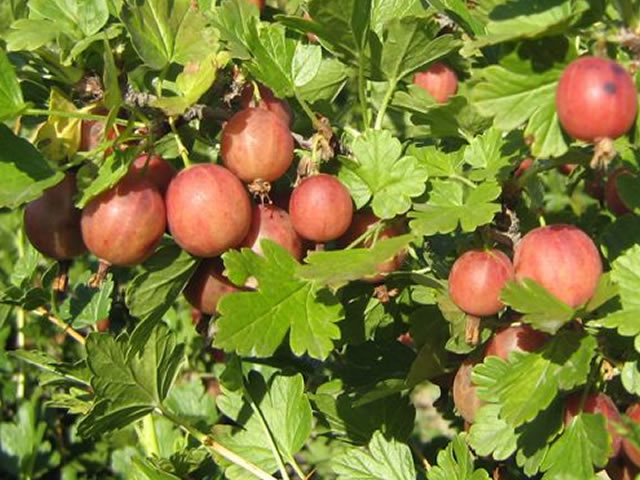Sweet and juicy gooseberry variety Yubilyar
When choosing a gooseberry variety, gardeners often give preference to the Anniversary. This is due to its many advantages, including high quality and pleasant taste of berries, unpretentious care and the ability to adapt to the climatic conditions of different regions. In this article, we will tell you in detail about this variety and the rules for its cultivation.
The content of the article
Description of the gooseberry variety Yubilyar
The variety belongs to the mid-season - the crop ripens at the end of July. Berries appear on the bushes 2 years after planting, the crop reaches its peak fruiting at the age of 4 years. Productivity - 5-6 kg per bush.
Reference. The bushes bear fruit annually for 15-18 years.
The crop is harvested by hand or with scissors, removing the fruit along with the stalks. At a temperature of + 5… + 18 ° C and an air humidity of 80-85%, the berries are stored without loss of taste and quality for a week.
History of origin and distribution
The jubilee was bred by breeders of the South Ural Research Institute of Horticulture and Potato Growing as a result of crossing the varieties Houghton and Bedford yellow.
It was added to the State Register of Russia in 1965, zoned for the Central Black Earth Region.
Bush characteristics

The plant is a vigorous (1.8 m high) compact bush with a powerful root system. Young shoots are green, turn light brown by autumn, perennial ones are dark gray, erect, smooth, with drooping tops and numerous long, hard and sharp thorns, collected in bunches of 2-3 pcs. and growing at right angles.
The leaf plates are of medium size, dark green in color, the upper part is smooth, shiny, slightly wavy, with deep veins, on the lower part there is a rare pubescence. The leaves are five-lobed, with uneven edges and obtuse short teeth, opposite.
During flowering (in mid-May), small pale green cone-shaped flowers with an anthocyanin base appear in the leaf axils, collected in inflorescences of 1-2 pcs.
Resistant to temperatures
Anniversary is a frost-resistant variety. It tolerates a drop in air temperature to -32 ... -50 ° C, flower buds do not fall off and form an ovary even in case of recurrent frosts.
Moisture and drought resistance
The bushes are characterized by a low degree of drought resistance. Lack of moisture leads to a decrease in yield, the formation of small and sour berries. With excessive watering and waterlogging of the soil, there is a risk of rotting of the root system and cracking of the fruits.
Disease and pest resistance
The variety is resistant to diseases and pests, but in case of violation of agrotechnical rules, excessive humidity of the air or soil, it can infect powdery mildew and gooseberry caterpillars.
Characteristics and description of fruits

Large berries (average weight - 5-6.5 g), round or rounded-oval shape. Covered with a smooth, thin, but firm pink skin with a burgundy fragment on the side facing the sun, characteristic yellowish longitudinal stripes and a thin layer of waxy coating.
The pulp is yellow, juicy, contains many brown seeds and has a sweet but not cloying taste with a slight sourness from the skin.
Areas of use
Yubilyar berries are consumed fresh, frozen, used for making fruit purees, compotes, jams or preserves.
Advantages and disadvantages compared to other varieties and hybrids
The main advantages of the Anniversary:
- stable and high yield;
- good commercial quality of fruits;

- immunity to diseases and pests;
- high degree of frost resistance;
- lack of tendency to shedding fruits and baking them in the sun;
- unpretentiousness;
- good taste, keeping quality and transportability;
- the possibility of universal use of berries;
- ease of propagation and rooting of cuttings in 100% of cases;
- long fruiting period.
Cons of the variety:
- the need for pruning;
- the presence of thorns;
- medium drought resistance;
- tendency to cracking fruits in case of low air temperature or excess moisture;
- exactingness to the amount of lighting.
Growing technology
The main conditions for good development of bushes and obtaining a bountiful harvest are the selection of suitable seedlings, correct and timely planting and proper care of the crop.
Optimal conditions
The hero of the day does not make special demands on the soil, but it grows and bears fruit better in light, loose soil with good aeration, moisture permeability and medium or low acidity.
A well-lit place is chosen for the gooseberry - even in partial shade, the shoots stretch out, flower buds develop poorly, and the yield decreases. The permissible depth of groundwater is 2 m.
Six months before planting the seedlings, the plot is dug to a depth of 40 cm and 10 kg of compost, manure and sand are applied per 1 sq. m of land, after which they re-dig.
When buying planting material with an open root system, preference is given to 2-year-old seedlings with 2-3 strong shoots at least 25 cm long, unblown axillary buds, uniform color, powerful, lignified rhizome 20-25 cm long, without leaves and signs of dryness, diseases or mechanical damage.
Reference. Such seedlings are purchased immediately before planting, since they can be stored for a maximum of 3 days.
Closed-rooted specimens should have shoots 30-50 cm long densely covered with pale green leaves and numerous white roots under a layer of soil.
Terms and rules of landing
Gooseberries are planted in spring, before bud break, or in autumn, in mid-September.
Before planting, the shoots of the seedlings are cut to 15-20 cm, leaving 5 fruit buds on them, and the roots are soaked for a day in a solution of the "Bud" or "Kornevin" preparations.
Landing scheme:
- On the prepared site, according to the 1.5 × 1.5 m scheme, dig planting holes with a depth of 0.6-0.7 m and a diameter of 0.5-0.6 m.
- Place a 15 cm thick layer of gravel drainage on the bottom of each.
- Mix the dug soil with humus, compost and peat (5 kg each), add 4 tbsp. l. "Nitrofoski", 2.5 tbsp. wood ash and 60 g "Agricola" for every 10 kg of the resulting soil mixture.
- Place a layer of nutrient mixture on the gravel.
- Place a seedling in the center of the hole, sprinkle it with earth so that the root collar is 6 cm deep.
- Water the plants at the rate of 10 liters of water each.
- Cover the tree trunk with compost or peat.
Further care
In June - July, the bushes are watered once every 3-5 days, pouring 10 liters of warm, settled water under each bush. Watering is carried out in the evening and only at the root.
The day after watering or rain, the earth is loosened. This contributes to an even distribution of the liquid and helps to avoid dry crust formation on the surface of the soil and its cracking in case of extreme heat.
Gooseberry Anniversary is fed twice a season:
- in early June - manure solution (1 liter of mullein per 10 liters of water) or mineral fertilizers with a high content of phosphorus, potassium and nitrogen;
- in mid-September - 1 tbsp. l. superphosphate and 20 g of potassium salt per 1 sq. m of land.
The first pruning of seedlings is carried out immediately before planting. The next year, 3-4 strong buds are left on each shoot, one-year-old growths are shortened by a quarter, and the branches thickening the crown and growing inward are cut into a ring. A year later, new shoots are shortened by a third, and zero ones are completely removed, as well as growths thickening the crown.
They act according to this scheme until the bushes are 8 years old. From this age, rejuvenating pruning is carried out: within 3 years, a third of all branches are completely removed or all shoots are shortened to 15 cm in order to activate the growth of zero shoots.
Reference. Places of cuts are treated with wood ash and covered with garden pitch.
Possible problems, diseases, pests
Diseases and pests that can affect this variety are described in the table.
| Disease / pest | Signs | Treatment / prevention |
|---|---|---|
| Powdery mildew | Mealy white plaque on sheet plates. | The affected parts of the plants are removed, the bushes are treated with Topaz during the fruiting period or Fitoverm if the berries are already formed.
For the prevention of disease, the plants after harvesting the leaves are treated with a solution of colloidal sulfur. |
| Gooseberry caterpillars | Fruit ovaries are damaged, larvae of caterpillars eat seeds and gnaw berries. | The foliage and soil are powdered with ash or tobacco dust, the plants are treated with the preparation "Fufanon", "Karbofos" or "Iskra". |
Wintering
In mid-September, water-charging irrigation is carried out (20 liters of water per 1 square meter of land), after which the bushes are spudded, the soil is mulched with peat and covered with dry leaves or sawdust. The branches are pulled together with a rope to avoid breaking under the weight of the snow.
Reproduction
Gooseberry Anniversary is propagated vegetatively - by cuttings or layering.
In early June, cuttings with a length of 20-25 cm are cut from lignified shoots, stepping back from the top of 40-50 cm. The cut points are treated with potassium permanganate and placed in fertile soil for rooting. In the spring, the cutting will form leaves and sprout. In the fall, it is planted in a permanent place.
For reproduction by layering, a branch located close to the ground is selected and cuts are made on it. A shallow hole is dug in the ground, a selected branch is placed in it, covered with soil and watered regularly so that the soil does not dry out. By the fall, roots will form at the site of the incisions, the layers are insulated for the winter, and in the spring, the rooted areas are cut with the help of a pruner and planted.
Features of cultivation depending on the region
Planting and care requirements of the variety do not depend on the growing region. The only thing that is important to consider is the negative impact of drought on the quality and quantity of the crop. Therefore, in the south, where the climate is characterized by hot and dry summers, plantings are watered more often and more abundantly, focusing on the state of the topsoil in order to prevent it from drying out.
Pollinating varieties
The jubilee is a self-fertile gooseberry variety. During flowering, bisexual flowers are formed on it, so it does not need pollinators.
At the same time, the yield can be increased by at least 35% if other varieties of gooseberries are planted nearby, for example:
- Kolobok;
- Honey;
- Krasnoslavyansky;
- Russian;
- Lighthouse;
- Donetsk firstborn;
- Plum.
Gardeners reviews

The gardeners liked the jubilee, which is confirmed by their positive reviews.
Raisa, Volgograd region: “I have 3 varieties of gooseberries growing on my site, among them is the Anniversary. He likes the fact that whatever the weather, I am sure that I will pick 5-6 kg of berries from the bush. Caring for the bushes is minimal, they have never been sick for the entire time. Perhaps this is because I spray the bushes with colloidal sulfur every spring. The only minus for me is a lot of large and sharp thorns. "
Vasily, Novosibirsk: “The Yubilyar variety was literally created for cultivation in Siberia - due to its excellent frost resistance, it grows well in cold climates.My bushes are planted in a lowland, on 2 sides they are covered with earthen elevations so that they are not damaged by the wind. So I do without additional shelter and water the bushes less often than recommended, because water flows into the lowland. The variety bears fruit annually, the harvest is rich, the berries are delicious. "
Conclusion
Anniversary is one of the few gooseberry varieties that, due to their high degree of frost resistance, are suitable for growing in northern regions with cold winters. It is characterized by large, sweet and sour fruits, consistently high yield, immunity to diseases and unpretentious care.